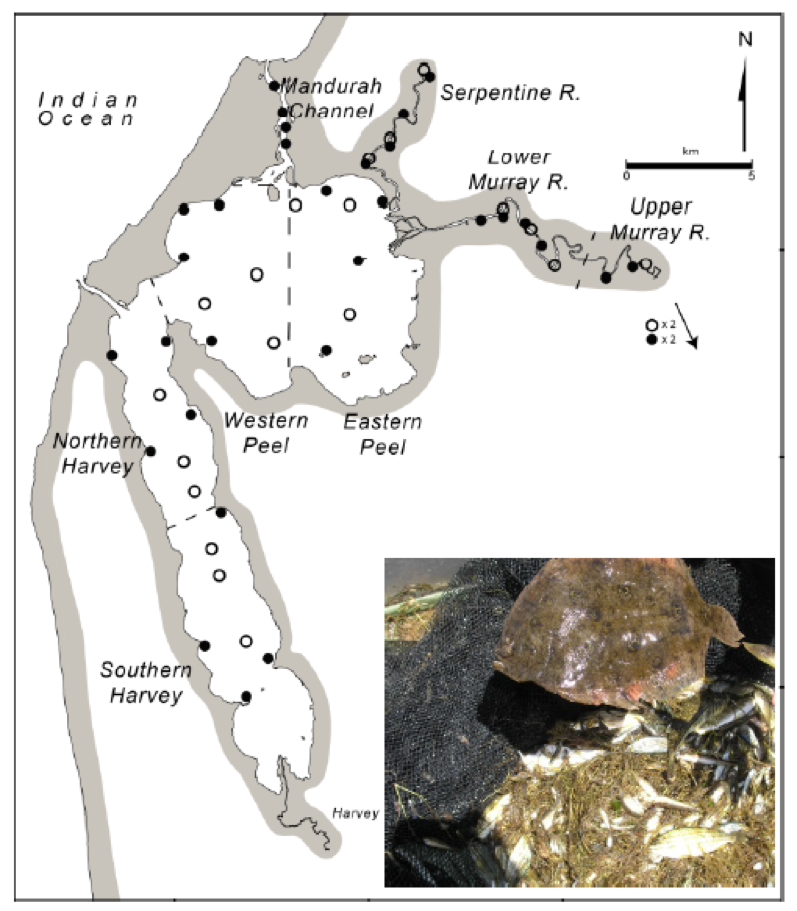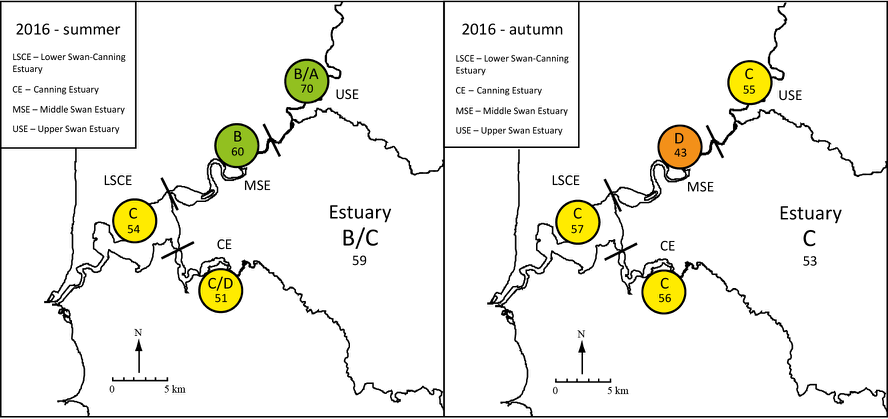Estuary Science/ Biotic Health
Background and rationale
Globally, indicators based on biotic (animal and plant) communities are increasingly used to monitor and report the condition or ‘health’ of estuarine ecosystems. Such methods provide an assessment that is more ecologically relevant than those based on water quality alone. This project will employ a range of approaches for developing indices of estuarine condition based on fish and invertebrate communities.
Estuarine ecological health response of the Peel Harvey
Led by Murdoch University researchers Dr Chris Hallett and Dr Fiona Valesini, and supported by PhD student Sorcha Cronin O’Reilly, this project component specifically aims to:
- (1) Characterise the fish and bottom-dwelling invertebrate faunas in the estuary and identify their environmental drivers of change
- (2) Use these faunal characteristics to develop biotic indices for measuring and tracking estuarine health
- (3) Quantify effects of the invertebrates on sediment-water nutrient flux.
For example, fish community data collected during this study (see figs below) will be collated with historical fish data sets dating back to the 1970s, enabling the development of a fish-based biotic index to quantify how estuarine ecological health has changed over time.
A similar index has previously been developed for the Swan-Canning Estuary, and has been applied using data from annual fish monitoring in each year since 2012 (funded by the Dept Parks and Wildlife). The health index is reported each year as ‘report card’ grades (A, excellent to E, very poor, see Figure). The same type of reporting approach will be developed for the Peel-Harvey as an outcome of this project.
To support the development of invertebrate-based indices of estuarine condition, a broad-scale survey of sediment condition was conducted at 100 sites throughout the estuary in November 2016, in conjunction with scientists from the Department of Water. Sediment cores were collected at each of these sites to (1) assess the condition of the sediment, both qualitatively (based on texture, colour, odour and the depth of any obvious oxygenated zone) and quantitatively (grain size, surface chlorophyll content and isotopes of carbon and nitrogen), (2) provide quantitative data for the estuary models, and (3) inform the design of the invertebrate sampling program.
A component of the project will also involve mapping of the distribution of seagrass and macroalgae throughout the Peel Inlet and Harvey Estuary. This work will repeat and update historical surveys (undertaken annually in 1978–2000 and most recently in 2009), as well as providing a benchmark for improved understanding of these plant community dynamics into the future.
Relevant Publications
de Lestang, S., Hall, N., Potter, I.C. (2003). Influence of a deep artificial entrance channel on the biological characteristics of the Blue Swimmer crab Portunus pelagicus in a large microtidal estuary. Journal of Experimental Marine Biology and Ecology 295: 41-61.
Hallett, C.S. (2014). Quantile-based grading improves the effectiveness of a multimetric index as a tool for communicating estuarine condition. Ecological Indicators 39: 84-87.
Hallett, C.S., Valesini, F.J., Clarke, K.R., Hesp, S.A., Hoeksema, S.D. (2012). Development and validation of a fish-based, multimetric index for assessing the ecological health of Western Australian estuaries. Estuarine, Coastal and Shelf Science 104-105: 102-113
Hallett, C.S., Valesini, F.J., Trayler, K. (In review). Use of a Fish Community Index to monitor and report the ecological condition of a hypereutrophic, urbanised estuary. (Environmental Monitoring and Assessment, submitted 21/04/17)
Loneragan, N.R., Potter, I.C., Lenanton, R.C.J, Caputi, N. (1986). Spatial and seasonal differences in the fish fauna in the shallows of a large Australian estuary. Marine Biology 92: 575-586. Loneragan, N.R., Potter, I.C., Lenanton, R.C.J, Caputi, N. (1987). Influence of environmental variables on the fish fauna of the deeper waters of a large Australian estuary. Marine Biology 94: 631-641.
Pedretti, Y.M., Kobryn, H.T., Sommerville, E.F., Wienczugow, K. (2011). Snapshot Survey of the Distribution and Abundance of Seagrass and Macroalgae in the Peel-Harvey Estuary from November/December 2009. Report to Department of Water. Institute for Environmental Science (Report No. MAFRA 11/1), Marine and Freshwater Research Laboratory, Murdoch University.
Potter, I.C., Veale, L., Tweedley, J.R., Clarke, K.R. (2016). Decadal changes in the ichthyofauna of a eutrophic estuary following a remedial engineering modification and subsequent environmental shifts. Estuarine, Coastal and Shelf Science 181: 345-363.
Valesini, F.J., Coen, N.J., Wildsmith, M.D., Hourston, M., Tweedley, J.R., Hallett, C.S., Linke, T.E., Potter, I.C. (2009). Relationships between fish faunas and habitat type in south-western Australian estuaries. Final Report. FRDC Project No. 2004/045. Murdoch University, Perth.
Wildsmith, M.D., Rose, T.H., Potter, I.C., Warwick, R.M., Clarke, K.R., Valesini, F.J. (2009). Changes in the benthic macroinvertebrate fauna of a large microtidal estuary following extreme modifications aimed at reducing eutrophication. Marine Pollution Bulletin 58(9): 1250-1262.
Young, G.C., Potter, I.C. (2003). Influence of an artificial entrance channel on the ichthyofauna of a large estuary. Marine Biology 142(6): 1181-1194.
Young, G.C., Potter, I.C. (2003). Induction of annual cyclical changes in the ichthyofauna of a large microtidal estuary following an artificial and permanent increase in tidal flow. Journal of Fish Biology 63(5): 1306-1330.




